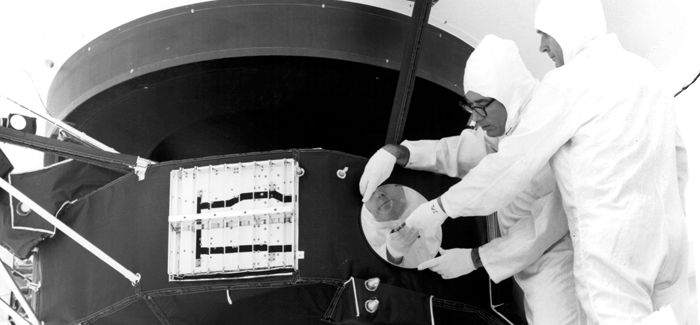
Golden Record is mounted on the mission module of Voyager 1. (NASA)
A sample of Voyager’s Golden Record.
In 1977 two identical nuclear-battery-powered Voyager spacecraft were launched, and almost 35 years later Voyager 1 entered interstellar space. Shortly after NASA made the announcement, I spoke with project scientist Ed Stone, SM’59, PhD’64, (Inquiry, Spring 2014) about Voyager 1’s departure and the Golden Record.
Affixed to the outside of both Voyager probes are identical gold-plated copper phonograph records inside an aluminum jacket with a cartridge and needle. Any intelligent life that finds it must learn how to play the record, so the dust jacket contains instructions in symbolic language.
[[{"type":"media","view_mode":"media_original","fid":"1450","attributes":{"alt":"","class":"media-image","height":"345","typeof":"foaf:Image","width":"460"}}]] (NASA)
The record contains pictures, music, greetings (human and whale), a variety of sounds, and messages from the United Nations and President Jimmy Carter. I understand how music is recorded, but I couldn’t figure out how pictures were encoded. Stone compared it to “old-fashioned television sets with cathode ray tubes.” A beam sweeps across the screen line by line, creating a picture based on the intensity of the beam at different points on the line. “The needle was moved in the groove according to how bright the image was at that point,” explains Stone. “It’s analog television.”
The Golden Record is a “cultural Noah’s Ark” according to Ann Druyan, who curated the record along with a small committee chaired by Carl Sagan, AB’54, SB’55, SM’56, PhD’60, whom she later married. Many of the greetings speak of peace, friendship, and longevity. Some send invitations to visit, but one says, “We are happy here and you be happy there.”
This sample of greetings is set against plasma waves recorded by Voyager as it traveled through interplanetary space, which translate into delicately creepy music, exactly what sci-fi movies would have us believe space sounds like. [[{"type":"media","view_mode":"media_original","fid":"1451","attributes":{"alt":"","class":"media-image","height":"229","typeof":"foaf:Image","width":"460"}}]]
The Golden Record tells the story of us, not just humanity but Earth as a whole—who we are, who we were, where we might be going. The soundscape includes natural phenomena, the rise of life, the birth of humanity, evolving technology, and blasting off into space. The record also includes Druyan’s brain waves as she consciously meditates about history and culture but drifts into thoughts of falling in love with Sagan. [[{"type":"media","view_mode":"media_original","fid":"1452","attributes":{"alt":"","class":"media-image","height":"229","typeof":"foaf:Image","width":"460"}}]]
But will anyone find Voyager, let alone decipher the Golden Record? Stone thinks it’s highly unlikely, given the expanse of the universe and how microscopic dust particles will eventually “sandblast” away the instructions. He says it’s not about them—it’s about us. “It’s a message for all of us on Earth—that we can actually send such a message.”
Sagan felt similarly: “The spacecraft will be encountered and the record played only if there are advanced spacefaring civilizations in interstellar space. But the launching of this bottle into the cosmic ocean says something very hopeful about life on this planet.”
Video
After decades of exploration, Voyager 1 reaches a historic milestone for mankind—interstellar space. Learn how the NASA team discovered the craft had reached the space between the stars.
